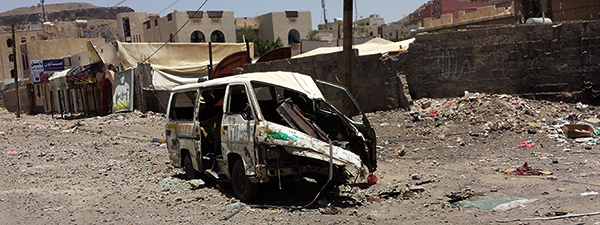
After more than three years of conflict in Yemen, more than half of the country’s health facilities are no longer functional and 15 million people do not have access to essential health care. Attacks on health facilities and health workers have directly contributed to the country’s 2017 cholera outbreak. According to the WHO, over 1,000,000 suspected cases and 2,000 associated deaths were reported in Yemen by the beginning of 2018. As cases of cholera began to subside, diphtheria started to catch hold--negatively impacting Yemen’s most vulnerable--children.
Yemen is one of the countries in conflict that the Safeguarding Health in Conflict Coalition and its members are monitoring closely. Violence broke out in early 2015 when Houthi rebels overtook the government. Saudi Arabia, viewing the Houthis as a threat in the region, created a coalition that began intervening militarily. For more than three years, civilians have endured sustained airstrikes in addition to heavy shelling on the ground.
The conflict has led to the near total collapse of the country’s already fragile health care system. Many medical facilities have been indirectly damaged and medical personnel injured or killed indirectly during the conflict; however, parties to the conflict have also directly targeted facilities and personnel. UNICEF verified 93 attacks on hospitals in Yemen from March 2015-December 2016. Ambulances have also been targeted with gunfire, stolen, and denied passage by parties to the conflict. The number of reported attacks on health care in 2017 is less than in 2016, however Saudi Arabia-led blockades of supplies continue to directly impact tens of thousands of people’s access to health care.
According to OCHA, only 45% of medical facilities are now fully functioning across the country and even these face severe shortages of medicine, equipment, and staff. This has left 15 million people, over half of the population, without access to adequate health care.
In October 2016, the World Health Organization warned the country was facing a cholera epidemic as a result of the conflict. The cholera epidemic intensified and spread throughout Yemen in 2017. By the start of 2018, cases of cholera began to subside in certain areas of the country, however diphtheria was on the rise. The risk of a country wide famine has compounded these and other challenges.
What can we do?
Coalition member Watchlist on Children and Armed Conflict has researched and reported on health care in Yemen, and advocates directly with the UN Security Council and the Security Council Working Group on Children and Armed Conflict to safeguard health care by implementing Resolution 2286 and Resolution 1998.
Join Watchlist in asking the UN Security Council to take these actions in Yemen:
- Call for the resumption of the cessation of hostilities agreement and ensure that child protection—including preventing and ending attacks on hospitals and schools—is on the agenda for ongoing peace negotiations.
- Condemn attacks on medical facilities and personnel and demand that all parties to conflict comply fully with international humanitarian law, and additionally, consider supporting the establishment of an international commission of inquiry to investigate alleged violations of international law.
- Implement Resolution 2286, formally accepting and reporting on the recommendations of the Secretary-General.
- Immediately schedule briefings on the situation in Yemen, which should include information on investigations and steps towards accountability that the relevant member state has taken.
- Additional recommendations for the Security Council, as well as the Secretary-General, the WHO, and member states relating to all countries in conflict are laid out in the Safeguarding Health in Conflict Coalition’s 2018 report on attacks on health (see page 15).
*Please help support Watchlist and the Safeguarding Health and Conflict Coalition protect health care from attack and share these recommendations on social media.
Read more about Watchlist’s work in Yemen.
Read more about the situation in Yemen in the coalition’s 2018 report.

